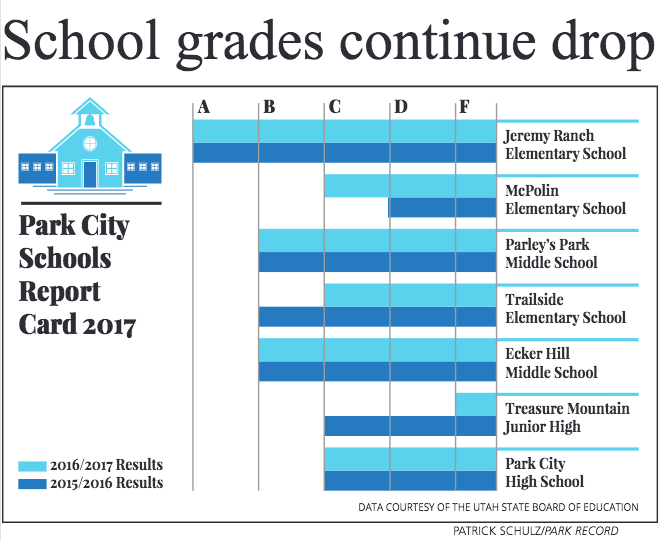Park City School District’s inappropriate contract highlights many issues
On Thursday, The Salt Lake Tribune reported about a state audit finding where “Park City School District awarded an inappropriate contract to a general contracting firm that later violated state law while acting on the district’s behalf.”
Basically our school district awarded a contract that included language that could incentivize Hughes Contractors to charge tax payers more money than they should. The Park City School District agreed to pay both project costs and an additional percentage on top of those costs. According to Utah State Auditor John Dougall, “You have an incentive to inflate the cost because then percentage of cost is a bigger number” in this type of contract.
Then Hughes, acting on the district’s behalf, didn’t properly bid out work. That’s illegal.
According to the Tribune, Park City School Board president Andrew Caplan generally agreed with the findings but stated that the contract with Hughes ends at the end of the year, so it wouldn’t make financial sense to pull the contract now. He did say that “any future contracts will obviously be carefully reviewed for compliance with the Procurement Code.”
School District spokesperson Melinda Colton then told The Salt Lake Tribune district officials would have no further comment.
We have at least four issues with this mess.
First, obviously it’s a big issue. It has provided an opportunity for improper use of tax payer money. Additionally, it shows that there was a lack of oversight by our district.
Second, we’ve heard from various sources around town that the school district is trying to be more tight-lipped — that communication is being tightly controlled. We’re not a fan of that, but we suppose that’s the prerogative of school district leaders, some of which can be elected or “un-elected.” That said, to have audit issues show state laws were violated, and then say that you’re not going to comment any more about it, isn’t right.
Our third issue is that this story had to be dug up in the Salt Lake Tribune. This should have been front page news for the Park Record on Saturday. We need real reporting from the Park Record. Sometimes that happens, but sometimes it feels like the Park Record is an advertising circular in the middle of the Sunday Paper. We need the Park Record to do its job all the time.
The fourth issue is something we’ve worried about since the failed school district bond in 2015. It seems that in most discussions of new or replacement buildings, the architecture firm VCBO is a part of the needs assessment. They have often driven the discussion and sometimes pushed for things like additional athletic facilities.We’ve assumed the bidding process was fair. However, we’ve always been concerned they will be part of the construction of these buildings as well. If so, it’s much like the issue the Utah State Auditor had with Hughes Contractors. If VCBO drives the architecture of buildings and then VCBO is involved with constructing buildings, it provides an incentive for VCBO to over-architect so that it increases the payback during construction. We shouldn’t put ourselves or VCBO in that position. It’s a potential conflict of interest — and one that hopefully this audit highlights.
The Park City School District is in a period of flux. The Superintendent is leaving. Two board members have resigned. Audit reports like the one identified by the Salt Lake Tribune highlight previous issues.
This is likely one of those times that warrants extreme public scrutiny of the Park City School District. It’s a time where we need to ensure that the future is brighter than the recent past.
What we learned from Summit County’s property tax increase
This week the Summit County Council voted unanimously to raise your property taxes. If you have a million dollar home in the Basin, this will increase your taxes by about $190 a year. While the County is forced by law to have “Truth in Taxation” meetings to explain the increase to the public, the final vote was never in doubt.
What will you get for your annual donation? You’ll get the to keep the level of services you have become accustomed to. That’s about it. They won’t have to close the library in Coalville. The Sheriff won’t have to cut deputies. Roads will continue to get repaired. There will be money for mental health services. Those are probably all good things.
However, one of the interesting things pointed out by resident Kristen Brown at the first truth in taxation meeting is that the county budget had increased by about $14 million since 2013. That’s a 35% increase in budget, while our population has increased by about 9% over that time.
We also learned an interesting fact in a conversation after the meeting with Summit County Finance Officer Matt Leavitt. He said that if every piece of property around the Basin, that was entitled to be developed, was somehow developed tomorrow, it would only provide $700,000 in additional tax revenues per year.
So, we have a rapidly expanding budget that probably is unsustainable. Growth won’t provide enough money unless we want to increase entitlements. Most people either aren’t willing to accept fewer services or aren’t willing to tell their elected officials they can get by with fewer services.
What did we learn? We all better get used to regular tax increases.
Who does the Park Rag endorse for Mayor?
Who does the Park Rag endorse for Park City Mayor? Absolutely no one.
Each election cycle we hope the Park Record will make the decision to stop endorsing candidates. Yet, it never comes. This year the Park Record endorses Andy Beerman for Mayor. Their reasoning:
- For six years he has been on the City Council as it has confronted tasks like growth and affordable housing
- He is a consensus builder and he compromises
- He has earned endorsements of other people
If you look over Dana Williams’ tenure as Mayor, you’d see similar things. He presided and managed post-Olympic growth. He has worked with others to achieve goals. People generally think he did a good job as Mayor.
The Park Record endorsement then tries to throw a bone to Williams by saying, “Few voices are as important in Park City as that of Dana Williams. But the former three-term mayor has proven he doesn’t need to be in office to wield it.” It references his fight for the Park City trademark. Yet, the same argument can be made for Beerman, who has been successful as a City Council person. He has proven that he doesn’t need to be Mayor to make a difference.
The endorsement concludes that Williams had his time to lead and now Beerman should too.
So, we are left with justification for each candidate that is generally equal. The difference maker is that one hasn’t been mayor yet. That’s hardly a reason to vote for someone.
That leaves us wondering why the paper wants you to vote for Beerman? Is he better for advertising? Is it personal? Is it the “popular” thing to say in certain circles? Is it a gut feel?
That’s why we don’t like endorsements. The Park Rag’s opinion is that you should make up your own mind, for your own reasons. Do you like the progress that the city has been making over the past few years? Beerman’s been part of that and maybe that sways your opinion toward Beerman. Do you like how Williams stood up to Vail during the trademark issue? Maybe that sways your opinion to Williams. Do you feel that the city has tried to do a lot on transportation and affordable housing but has few results. That may sway you against Beerman. Maybe you didn’t like how Williams handled the recession and are worried how he will handle the next one. That may sway you against him.
The point is that choosing a candidate is personal and nuanced. The reason you would choose candidate x over candidate y is likely very different from the Park Record’s reasons.
That said, we like what the Park Record does with its Voter Guide. The information, in the candidates’ own voices, is helpful.
We don’t have a dog in the fight and think both candidates would be fine choices for different reasons.
Good luck making your decision.
The Park City forecast is warm and snowy
Before we know it, chestnuts will be roasting on an open fire. You, like everyone else in the valley, may have bought your Epic pass. Or you may have decided to spend the winter at the new Whole Foods, which we’ve heard is gorgeous.
Regardless, you and the 35 million people descending on Park City for winter, will have to deal with what mother nature has in store. So, what does the NOAA predict?
They say there is a greater than a 40% chance it will be warmer than normal … which typically means it really will be warmer. There is a greater than 30% chance it will be wetter than average.
That sounds a bit like last year. We’re hoping we will see no rain in January.
Who knows how it will ultimately turn out… but it’s fun to speculate.
We’d like to see 700 inches of snow with temps in the single digits all winter. We do live in the mountains, after-all, and life should be a little hard. That’s just our perspective, though.
Regardless, winter is coming and it’s a good time of the year.
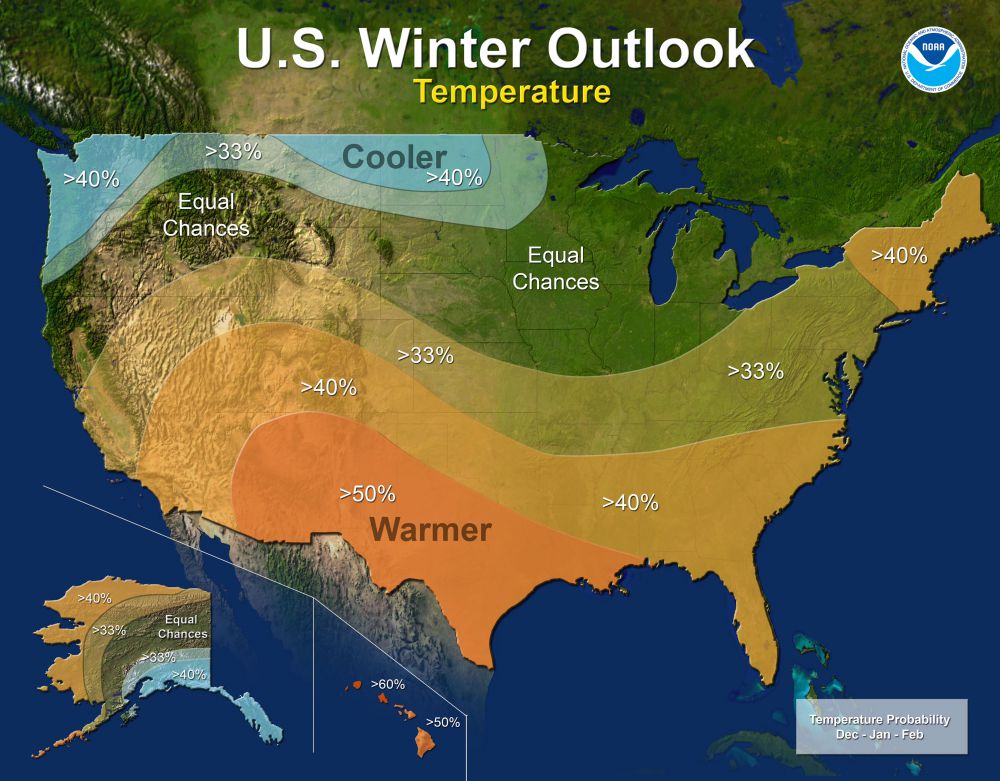
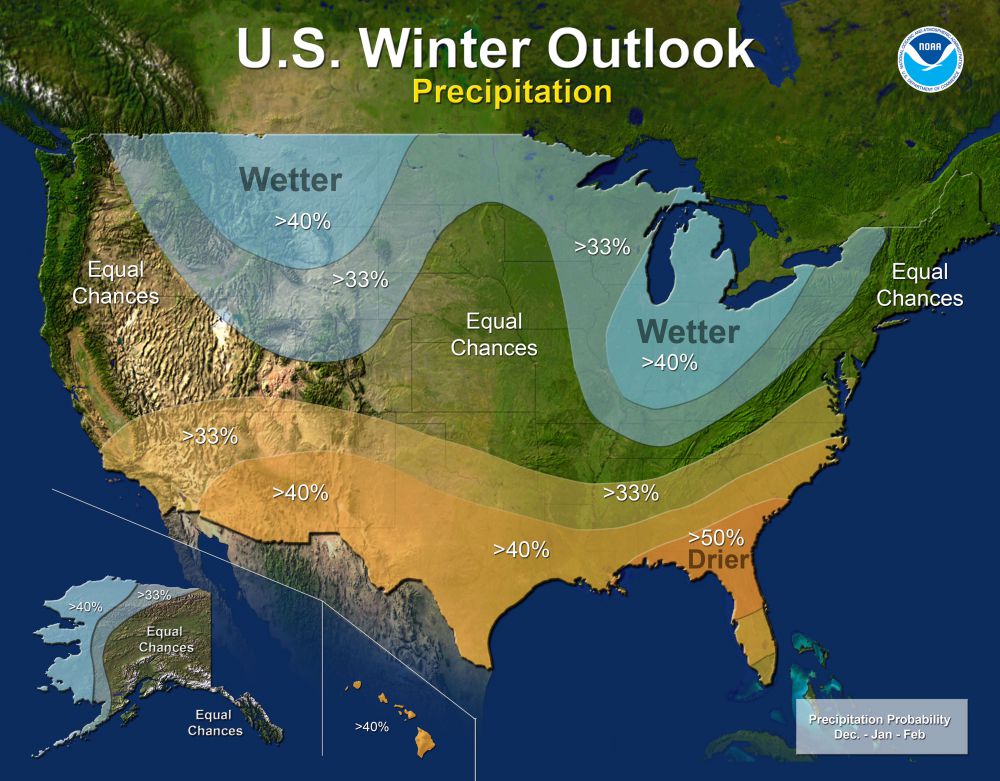
Is Park City hard to get to?
One of the things I’ve always heard is that Park City is so easy to get to, that we will always be flooded with tourists. It makes sense, with us being around 30 minutes from the airport. You compare any Colorado destination, and the distance from Denver is usually in the 1-2 hour (or longer) range.
This morning I was reviewing a presentation from the Chamber and it had a study results slide. The study took into account 1800 persons from 8 markets. Naturally it found that Park City was way above average on being family-friendly, providing a variety of activities, etc. However, we barely ranked as average (not in the top 25%) in “easy to get to.”
I’m not sure if survey responders just don’t know where Park City is, perhaps they have had some bad winter driving in Parley’s Canyon, or maybe they are just pissed that the Uber-Copter no longer flies, but was a little surprising.
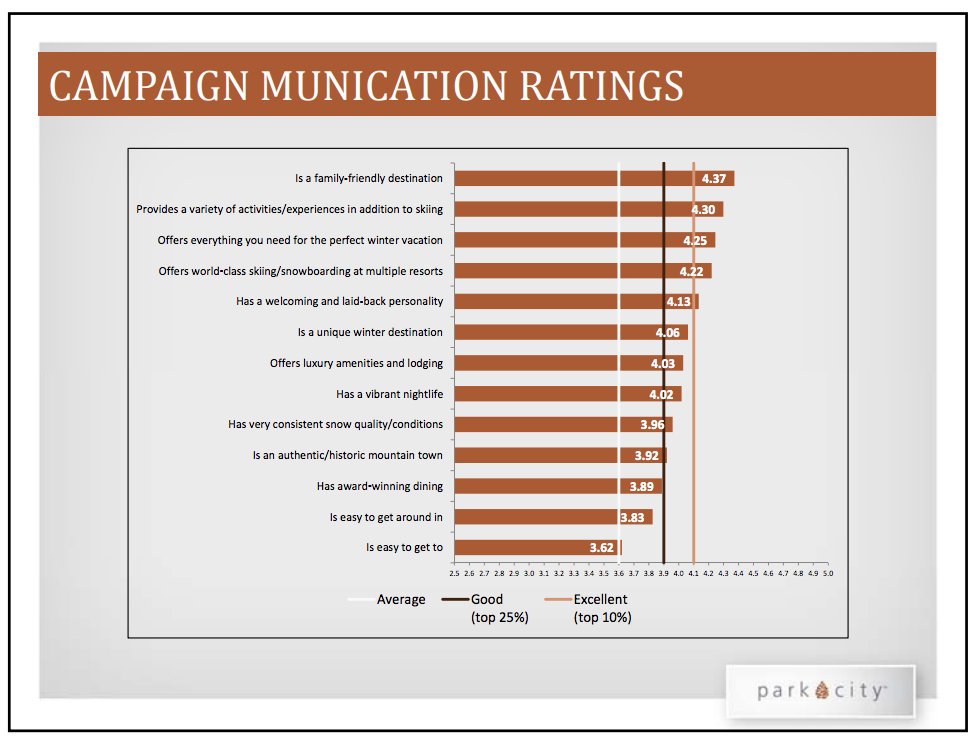
Interested in the Chamber of Commerce’s Summer results and Winter marketing? Here’s a preview.
Today the Park City Chamber of Commerce is presenting to the Summit County Council on its Summer results and Winter plans. Since the Chamber is substantially funded through Transient Room tax dollars allocated by the County Council, and there were discussions earlier this year about revisiting that allocation, this meeting is an important one. Here are a few of the slides that will be likely be presented:
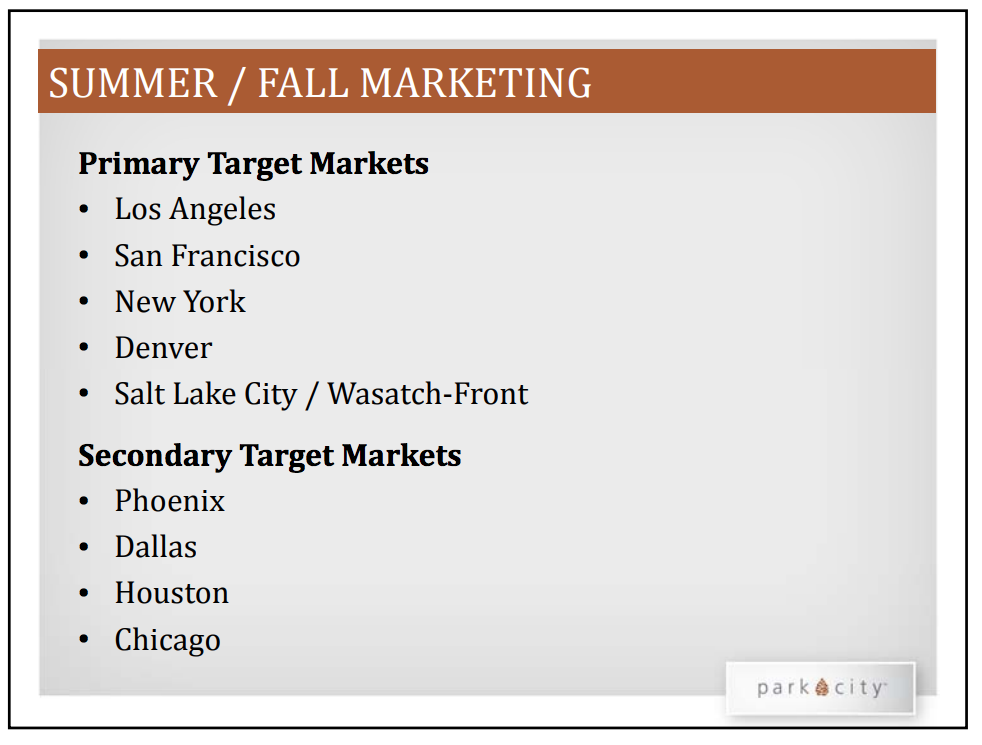
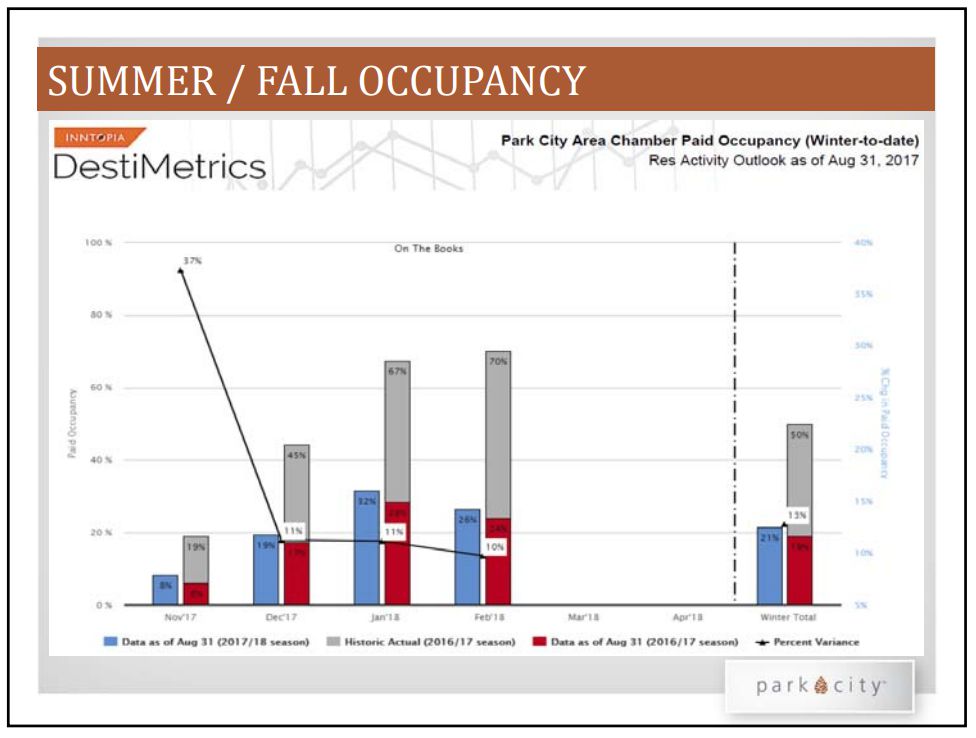
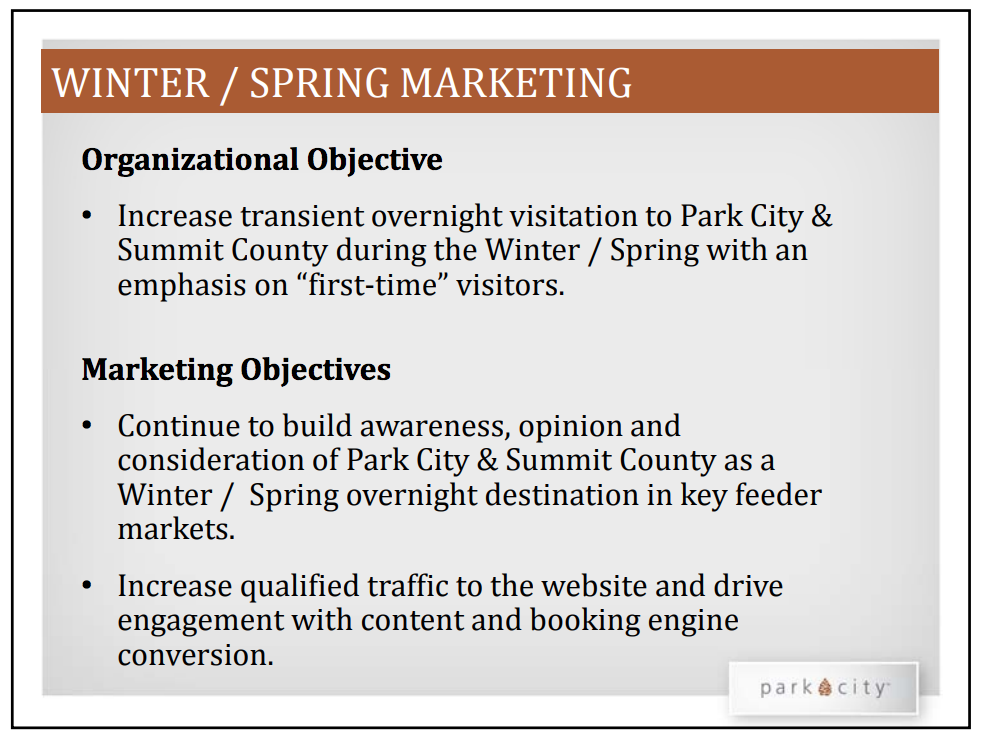
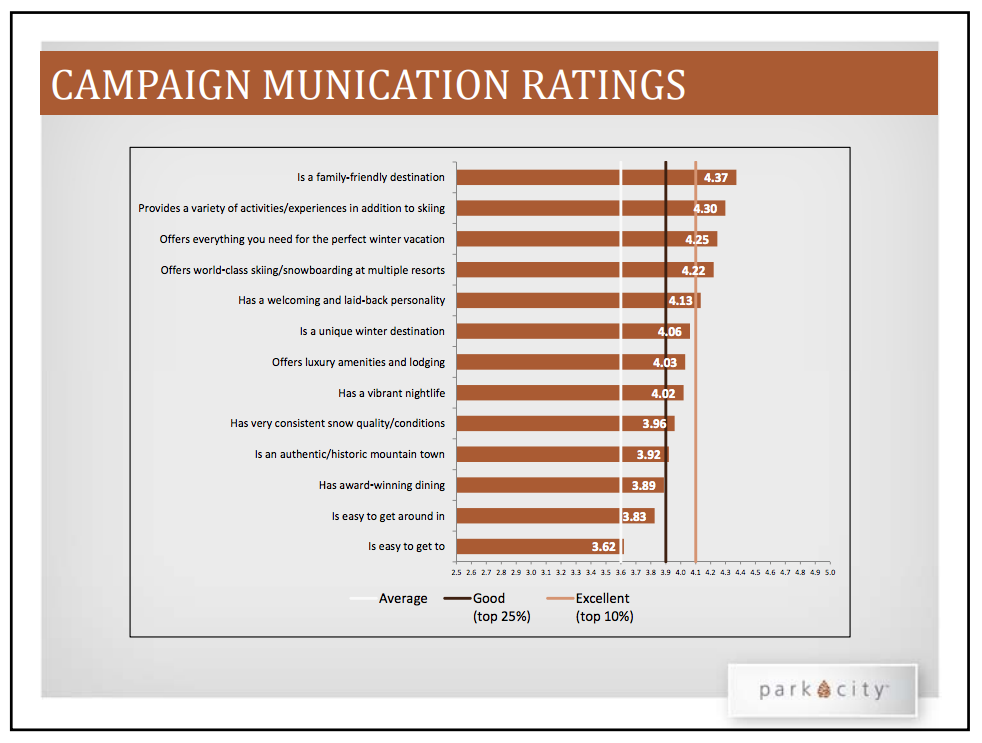
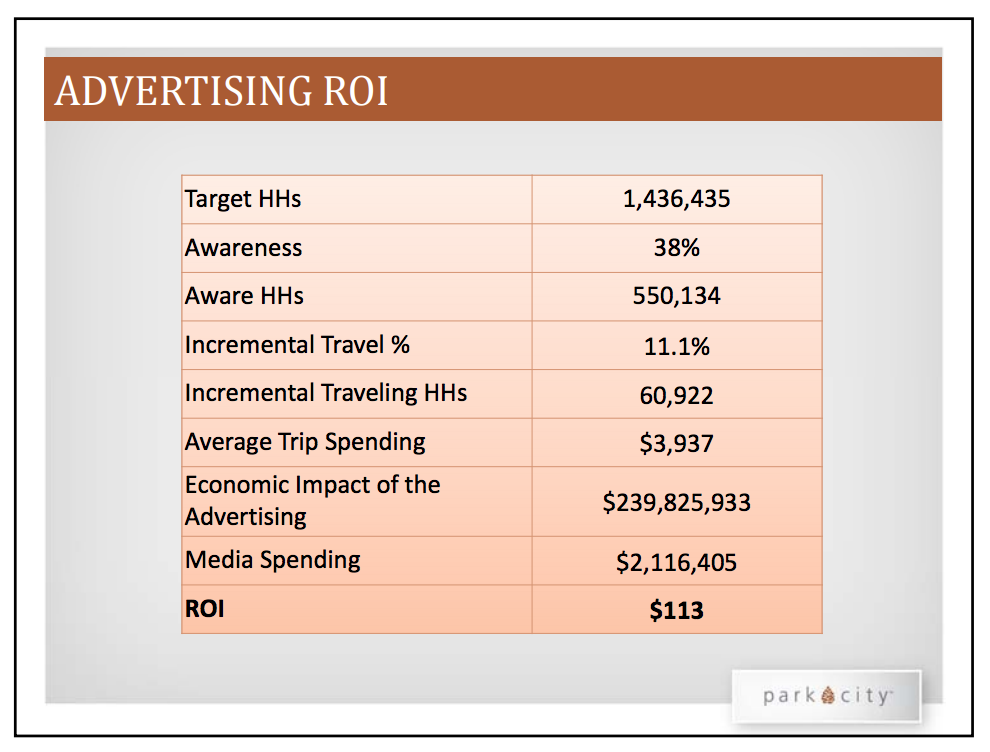
Again, if you’d like to see the whole presentation, you can click here.
We’re not made of money
The spat between the County Council and Summit Land conservancy over the purchase of the Osguthorpe Farm highlights a problem. Our governments aren’t made of money. Summit County offered to pony up $4 million to help Summit Land Conservancy buy the land, but the land conservancy needs $5.5 million to complete the purchase. The land conservancy rejected the county’s offer due to a number of conditions that the county apparently made with offer. The fact that the county says they can offer $4 million is surprising in itself.
The problem is that we spend millions on Bonanza Flat. We spend millions on the Cline Dahl’s parcel. We may spend millions on the Osguthorpe Farm. Yet, we have to raise property taxes because we can’t cover expenses (like roads). We get that each of those projects (Bonanza Flat, etc) have their merits… but not when you are broke. It’s like having no money, buying a Tesla, and justifying it because it’s emission free.
Some day, not too far away, these chicken are going to come home to roost.
How desperate are we for affordable housing?
There are a few things in the Park City area that nearly every local agrees upon. One of those is the need for affordable housing. Unfortunately during the last few years, not much affordable housing has come online. It appears that Summit County is trying to accelerate that process. The question is, at what cost?
Last week, the Summit County Council met in joint session with the Snyderville Basin Planning Commission to discuss affordable housing at Silver Creek Village. Silver Creek Village is the new development by the Home Depot. Once completed it will be one of the most populous neighborhoods in the Park City area. There are also a sizable number of affordable units as part of the project.
According to Mountainlands Community Housing Trust Executive Director, Scott Loomis, this is the type of affordable housing the community needs. It will a mix of rental and purchase units. A portion of the affordable units will be target to those making 25% of area medium income (AMI). That would be about a $25,000 annual salary.
There aren’t many of these types of units available in the Snyderville Basin currently. In fact, we often shake our heads when we hear the terms affordable or attainable housing. That’s because sometimes they are $400,000 or $500,000. That’s not exactly cheap or something attainable by a person making just over minimum wage.
330 units are slated to be completed as part of the project. It’s been estimated that the area needs about 1,000 affordable units over the next five years. Silver Creek’s number, combined with the approximate 500 units (1000 beds) at the base of the Canyons, the 78 units at Park City Heights, and the 52 upcoming units as part of the Discovery project, means we would be close to meeting affordable housing needs.
Therefore, there’s a lot to be excited about with this project and the potential for affordable housing around Park city and the Snyderville Basin. So, what’s the issue?
It’s a matter of planning.
The Snyderville Basin General Plan, and the development agreement that represents Silver Creek Village, states that the affordable units must be integrated into the development. The idea of true integration is that for every four or five townhouses, condos, etc. there will be one affordable unit interspersed with the more expensive units. The idea is that you don’t put all affordable units in one area, because it’s not optimal for community integration. Economic segregation has shown to have negative mental and other health effects. It’s also shown to have negative impacts on children.
It really just makes sense. For one of the largest developments in the Park City area, do we want million dollar homes in one area and all the affordable housing put into another area? It seems reminiscent of the projects in 1970’s Chicago. No, it seems the optimal outcome would be to have affordable units mixed in with market rate units. This allows for economic diversity and probably cultural diversity, too.
Yet, the desire by the Summit County Council and Mountainlands Community Housing to push forward with little-to-no integration of units is glaring.
County Council Member Roger Armstrong says, “We can wait and design what may be perfectly integrated, and people feel like a part of the community, but we will still be further and further behind [with affordable housing].”
The other problem with non-integration, of course, is that it violates the Snyderville Basin General Plan — the document that guides development in the basin. The General Plan calls for affordable housing to be integrated into the development. Snyderville Basin Planning Commissioners cited the upcoming Discovery development (above Weilenman School) as a design that had become fairly integrated. So, it is possible top achieve.
Much of the talk during this meeting turned to whether the Planning Commission could find a way to define the development’s affordable housing as integrated. It looks like Mountainlands had already conceded that their original plan was not integrated, so they came up with a revised plan. The revised plans spreads out the affordable housing a bit, but it’s probably not truly integrated.
Planning Commissioner Chair Canice Harte commented that the design did look more integrated but that this was a the first time the commission had seen it. The Planning Comission is going to meet again in the upcoming weeks and discuss integration.
The problem, as we see it, is that community integration is a little like pornography — you’ll know it when you see it. When we look at the revised plan by Mountainlands we suppose it does look a little more integrated than the original plan. However, that is only because we are comparing it to a completely non-integrated design. On its own merits, we don’t think the community will be truly integrated with the new design. Of course the Planning Commission could see it differently.
The other problem we see is that even having the meeting is a sign of throwing out the rules. This meeting was held, the best we could tell, so that the Planning Commission could be convinved that they should not worry about integration…. and then if they did… to tell the County Council… so the County Council could amend the development agreement so that it didn’t have to be integrated. Mountainlands Director Scott Loomis said he even had the amendment ready to go, and intimated that it may have already been agreed upon. If that’s true, and it’s now standard operating procedure, every applicant for development who runs into issues should be able to have a joint meeting with the County Council and Planning Commission to work out differences. The fact that this meeting even happened seems outside the norm.
We’re not blind to reality, though. We understand why many of the council members want to move forward quickly. They are pushed by the public and have run on platforms of addressing affordable housing. It’s also true that there is a dearth of affordable housing and not much has been actually accomplished on that front. It has to be frustrating.
The argument for ignoring integration is that you can front-load building of affordable housing. You can build a large amount of affordable housing in a few areas at the beginning of the project. It can get affordable housing up quickly. Conversely, if you want a truly integrated design, these affordable units would be built over the next 15 years, as the development is built. So, it would take a while to build them and the area wouldn’t get an immediate affordable housing infusion. It’s also likely that some of the affordable housing would be done by the developers of the market-rate units. This would likely mean they would charge as much as they could for each unit and not make units available to people making $25,000 a year. So, there are advantages to damning the torpedoes and going full speed ahead.
That said, one of the first things we learned about development in Park City sticks out. You have to make good decisions before you build something because you can’t unbuild it. The decisions made on this will last forever and since this development is so large, we as a community have to get it right.
It’s also important to point out that not everyone on the County Council thinks this is a good development for affordable housing. Long-time developer and County Council member Doug Clyde said during the meeting, “This thing is a village in only name. I’ve been Developing for 30 years and I’ve never had a project not called a village. This is not a village. There is no walkable community here. There are no restaurants. There are no stores here. It will never be that sort of density. This is a bad place for apartments… because they are going to have two types of [driving] trips… one to work, one from work, one to the store, one from the store, one to the school, one from the school. Putting apartments up here is putting five times as many trips on the road as if they [workers] come from Salt Lake. It’s a bad place for them. It’s a bad location… Frankly, I’d rather see less workforce housing. I’d rather see fewer units because I don’t think this area will ever be positively serviced by transit.”
Mr Clyde knows his business and in the long-term there is a good chance he’ll be proven right. However, we are confident that one way or another there are going to be over 300 units of affordable housing at Silver Creek. It’s just a matter of how it is done and when.
We think we owe it to the long-term vision of the Park City area to do this one right. In some ways, this one already seems a little tainted. However, we do still have the opportunity to make sure we are doing this in the right way — adhering to the values that have been set forth in the General Plan.
If we don’t, it will likely be another of those developments that looks very foolish in hindsight. It will be one of the developments someone looks at in 15 years and says, “how did they ever let that happen?”. We may get 300 units of affordable housing in 2019 but at what long-term cost.
The Kids are Alright: Why we never want to hear about the SAGE test again
The Park Record headline screams:
We especially like the chart’s title: “Park City Schools Report Card 2017”. This must be official!
Wow, did a virus invade and destroy the childrens’ brains at Treasure Mountain. It must have because the same kids who were getting B’s at Ecker Hill and C’s at Treasure Mountain last year are now getting F’s. There must have also been huge teacher turnover in order for the education to have fallen so far so fast. There must be a fundamental issue with education in Park City that we need to solve today!
Or it’s all just bullsh*t.
We’ll take the latter.
SAGE is a standardized test given to Utah students since 2013. The Utah State Board of Education mandates that schools provide this test to students annually. The results of the test can be used by teachers and administrators to help individual students and to judge academic growth. The results are then used to label a school with a grade (A-F). For Park City High, SAGE forms part of the grade. For all other schools in our district, SAGE results determine the entire grade.
So, slapping Treasure Mountain with an F simply means it’s SAGE tests weren’t great. That must mean something right? Let’s look at the scores of the best high school in Utah according to US News and World Report. That would be Karl G Maeser Preparatory Academy. What are their SAGE scores:
- 51% of students are proficient are language arts
- 59% percent are proficient in math
- 53% percent in science
What about the number two high school in Utah, Park City High? 51% proficient in language arts, 51% in math, and 53% in science.
If either of these scores were indicative of a “Report Card,” as the Park Record calls it, then the entire staff and administration of both Karl Maeser and Park City should probably be let go. The better question is do you think our students are a bunch of dumb-ass*s? Probably not. Do you think our teachers are a bunch of know-nothings that can’t educate anyone out of a bag? Probably not.
So, why are test scores so low?
Former Alpine School District Board of Education member Brian Halladay would likely tell you that the company that designs the SAGE test isn’t qualified. In a 2015 email to parents, Halladay says that the SAGE test was designed and created by AIR, “one of the world’s largest social and behavioral research companies” and not by teachers or educators. He recommended that parents opt out of the test.
That leads to the second problem with judging schools based on SAGE scores… kids opt out. In Park City 21% of kids opt out. Do we know if the best-test-taking-kids are the ones opting out? No, but it makes sense.
The third-reason why test scores may be low is that some students don’t take it seriously. According to the Park Record article, Park City District Spokeperson Mindy Colton says that kids are “sabotaging” the test scores by finishing too quickly or drawing on the back of tests. This isn’t new, though. A report we read talks about students in 2004 in New Mexico that like to make Christmas Trees and Battleships out of the answer bubbles. If kids don’t find the value in it, they aren’t going to waste time or effort.
So what is the SAGE test good for? Absolutely nothing. It’s good for a student who wants to use it, in cooperation with their teachers and parents, to improve parts of their education (the PCSD also uses the Galileo tests for this purpose). It’s not a referendum on our teachers. It’s not a a final grade for our schools. It’s not an indication of educational success of our district.
In our opinion, the worst thing parents could do is go to the Park City School District and demand that we are #1 in SAGE tests. Please do not email TMJH Principal Emily Sutherland and demand action. The outcome of that will be that the school district will be pressured to improve SAGE results. How do you do that? You teach to the standardized test.
Is that what we want?
This isn’t to say that Park City’s education is perfect. It’s true that our kids are going to be competing against kids from states that spend more on education. It’s true that students in Korea spend day and night at school in order succeed later in life. It’s true that almost every school district wants to achieve the results of Finland. It’s true that Park City still has an achievement gap related to English language learners.
However, the grades assigned to schools based on SAGE scores isn’t going to make any difference with any of that.
To be fair, we at the Park Rag have brought up SAGE scores in the past. We’d like to think we have a better perspective now. You’ll likely never read another article on the Park Rag correlating SAGE scores with our children’s education.
We also hope we never have to read another article in the Park Record that cites the results of SAGE testing. We hope we never have to read the school district getting defensive about the scores of a standardized test. It’s meaningless in the aggregate. We believe it has little to no influence on the whether a child gets a good education in Park City.
We hope instead our parents, schools, and media will continue to focus on providing a quality education to all students. That, and not SAGE, is what has the greatest potential to provide a superior educational experience to our kids.
Is Park City’s E-Bike system successful? The numbers don’t indicate that… but we hope it eventually will be.
We received a tip from a reader pointing us to a Park Record article about both the success and troubles with the Park City/Summit County E-Bike program (Thanks to the person who sent it in).
We’re honestly conflicted about the E-Bike program. We want to see it succeed because we ultimately believe e-bikes blend transportation with the best parts of Park City. Yet, we can’t let go of the issues they have had. Every week we hear from someone who have had serious problems with the program. Yet, the company that is managing the program uses veterans of foreign wars to help support it. How can you be too critical of people who have served our country and likely saw things that you or I would never want to experience?
It’s complicated.
So we come back to numbers. The Summit County Officials said that there have been 7,000 rentals of bikes and that success “shocked” them (in a good way). The Park Record article stated there were 80 bikes being rented. We know that the program has been operating for 49 days (since the end of July). That means that each bike was used 1.77 times per day.
So, it’s likely that each bike used for about a hour or two a day. That’s great! Or is it?
Wikipedia tells us that a well functioning bike share is used 10-15 times per day per bike. However, our system is new and just getting started — so perhaps we should expect less (for now)? Other sources, seem to state that between 6-10 uses per bike per day is normal. The question becomes how much traffic is taken off the road. If each bike is used 1.8 times per day, and 75% of that usage takes a car off the road. That means 108 cars are taken off the road each day (at least during summer). Is that worth the money? It may or may not be depending on when the usage happens.
We’ve also heard that people are driving up from the valley to try it out. We’re not sure if that is actually taking cars off the road, which was the reason we spent a million dollars (including grants) on the project. We’ve also been to many concerts where people are just “trying it out” as they ride around New Park.
That gets us back to the meat of the argument. The E-Bike share was designed to get cars off the road. It is a traffic mitigation concept. The Park Record article did not address that at all. If the city and county are providing an electric cruiser bike “for fun” at $2 an hour… that’s sounds like entertainment. So, how many cars have been taken off the road? Are visitors not renting a car? Are people from SLC parking at the library in KJ and taking a bike? Are residents using a bike and forgoing a car to do their daily tasks (or recreation)? Ultimately, that is the test of success.
So, it sounds like we need about 3-5 times more riders to meet the average “biker-ship” seen with a bike share. Stated positively… We have goals that we can aspire to.
We’re nearing the end of the summer. According to initial estimates the E-bike share will run into November. We’ll believe that when we see it (you won’t see me on my Pedego in November very often). How is that battery going to last when the snow falls and temperature drops? How will those thin tires tackle snow?
We see the future in the quote from the Park Record article…County Manager Tom Fischer said, “Our biggest thing is before we get into buying more bikes, which the early days shows the demand is there, we want to make sure we evaluate the whole thing. And we may have to look for a different provider. But, it’s clear from the early experience that people want it and they can use a system like this in our community.”
What we hope to see is that people adopt E-Bikes as an alternative form of transit. We hope that cars are taken off the road. We hope that it is seen as more than a novelty.
The numbers tell us that the city and county need to increase the usage by about five fold and then also show that those users are forgoing car tips… in order to show that the program is truly meeting the goal of reducing traffic.
We look forward to seeing what happens in Spring 2018.

